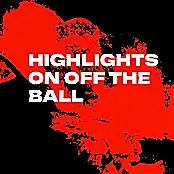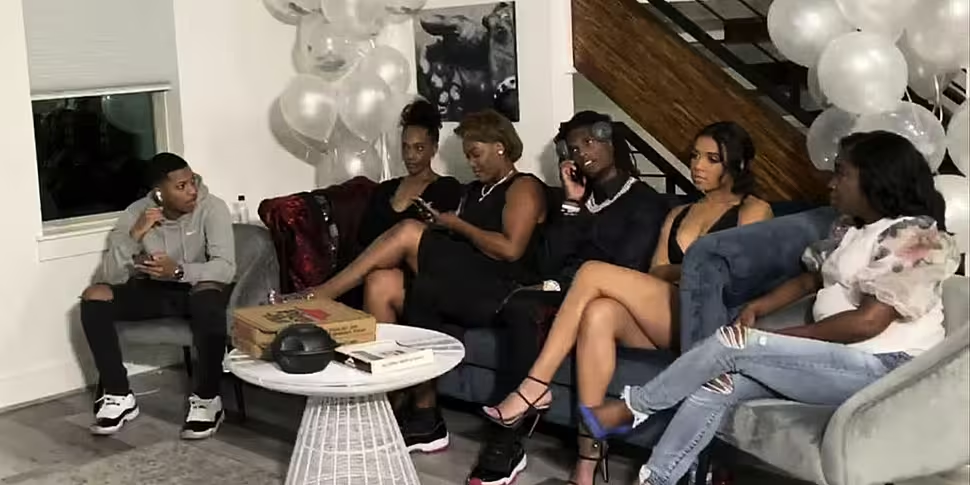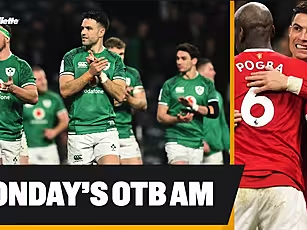The 2020 NFL Draft mostly went off without a hitch. The NFL managed to pick college players like normal despite the abnormal circumstances of this calendar year.
Broadcasting the draft in a Covid-19 world was always going to be a huge challenge. ESPN and NFL Network did the best job they could have possibly done. There were no major mistakes and the clunkiest aspect of the presentation was Roger Goodell's awkwardness when interacting with his tv. In terms of entertainment value, the production was on point.
Yet, this was still a boring draft.
It had nothing to do with Covid-19. Instead, the problem was the predictability of the whole thing. There were no real surprises. The draft is known for shocking selections (Daniel Jones last year), blockbuster trades (Devin Bush last year) and constant drama. Without an unnecessarily extravagant stage and fans losing their minds, it was always an uphill task. Goodell would have desperately wanted this draft to be more of a spectacle than it was. He had a whole new audience tuning in, there was literally nothing else in sports to watch.
Goodell has been trying to make the NFL ubiquitous ever since becoming the league's commissioner in 2006. The American sport with the shortest season has become the country's only year-round sport. He wouldn't have seen Covid-19 as a problem, but rather as an opportunity.
The NFL had the biggest stage its ever going to have for an offseason event. And it wilted.
Maybe the lack of opportunities to evaluate players led to such predictability. Maybe teams were reluctant to make aggressive trades or take more off-the-radar selections because they had fewer opportunities to evaluate the lesser-known names in the game. Ultimately, the most surprising aspect of the first round was the order in which the wide receivers went. Henry Ruggs went first, Jerry Jeudy followed and CeeDee Lamb fell to the Dallas Cowboys.
But even straight-forward drafts have winners and losers. Just because so many teams made the picks we expected them to make, it doesn't mean there aren't going to be big repercussions moving into the upcoming season.
Winners
1. Cincinnati Bengals
It wasn't a difficult choice. Joe Burrow was the obvious option at first overall. The Bengals had to simply avoid making a mistake to come away as the biggest winners in the draft. Luck plays a big role. They got the first overall pick during a year in which a top-tier quarterback prospect came out. While that doesn't guarantee that Burrow won't be a bust, it's what every team hopes for when they endure a losing season.
What we don't know at this point, and we'll likely never know, is what trade offers the Bengals were presented with. Turning down a Robert Griffin III trade package for Burrow would have been a mistake, depending on the team offering. Had they received a top-10 pick this year and a first-round pick in each of the next two drafts they could have got greater value.
That would have been the less socially-acceptable approach though, opening the door for significant criticism.
A.J. Green is unhappy on the franchise tag in Cincinnati. Green will likely stick around for Burrow's rookie season. Tee Higgins will try to replace him once he leaves. Higgins has a similar frame to Green but had far too many drops in college and lacks the ball skills to make the difficult adjustments that Green has made throughout his career. He's an upside pick at the top of the second round.
2. San Francisco 49ers
When the San Francisco 49ers traded DeForrest Buckner to the Indianapolis Colts, a large hole opened on their defensive line. Buckner is one of the best defensive linemen in the league. The 49ers traded him because they didn't want to pay him what it would cost to retain him. Getting a high first-round pick back was good value. Turning that pick into Javon Kinlaw, one of the most talented defensive linemen in this class, and a third-round pick was great value.
Kinlaw won't be as good as Buckner this year, but he has the potential to be an immediate impact pass rusher as part of the rotation upfront. Long-term, he likely won't be as good as Buckner either but he at least has the potential to match him. Buckner has a rare combination of size and athleticism which normally can't be found without a top-five draft pick.
After trading down, the Buccaneers traded up with their second pick in the first round. Brandon Aiyuk will be Deebo Samuel's partner at wide receiver moving forward. Aiyuk cost the 49ers three picks but he's worth it. He's a smooth route runner with strong hands and the ability to make difficult adjustments at the catch point. Aiyuk is an ideal fit in the 49ers offence. Kyle Shanahan should allow him to prosper from the start of his career.
3. Carolina Panthers
The Carolina Panthers lost their identity on both sides of the ball this offseason. Cam Newton was let go and Luke Kuechly retired. Instead of entering an aggressive rebuild, they made smart moves in free agency. Teddy Bridgewater and Robbie Anderson were outstanding additions to the offence. Bridgewater especially has the ability to change the direction of the offence. Defensively, the Panthers made two strong moves in the first two rounds of the draft.
Derrick Brown could very easily wind up the best player in this draft. Chase Young is a special talent but Brown is right there behind him. He's a bull-like interior defensive lineman who can dominate against the run while also providing penetration on passing plays. Brown doesn't have the highlight-reel explosiveness of Aaron Donald, which is the only reason he fell as far as he did in the first round.
Yetur Gross-Matos was the Panthers' second-round pick. Gross-Matos is a long athletic defensive end who will be able to win with power and speed in the NFL. He's not elite at either but good enough with both to win consistently. His size alongside Brown and Kawaan Short will be a big problem for opposing offensive lines.
The Panthers already had Stephen Weatherly, a free agent addition this offseason, and Brian Burns, last year's first-round pick, on their defensive line. Adding strength to a strength is a smart strategy. It can have a knock-on effect on the rest of your defence. If the defensive line dominates the way it projects to, the linebackers and defensive backs will have easier assignments. Running plays will be shut down at the first line of defence more often and passes will have to come out quicker.
4. Tampa Bay Buccaneers
So long as Tom Brady doesn't get shot as he meanders through public parks and enters the houses of strangers, the Buccaneers offseason will be positive.
When Brady went to Tampa Bay in free agency, the biggest concern about his fit with the team was the quality of the offensive line. It's still a concern, but adding Tristan Wirfs goes a long way to addressing that problem. Wirfs fell much further than anyone expected him to. David Gettleman went on his own route with the fourth-overall pick, that set in motion a sequence where offensive tackles were selected for their fit rather than just their talent.
Wirfs fell through the cracks. He's the best offensive tackle in this class, a ready-made starter at right tackle. The Buccaneers traded up one spot and paid a premium price to do so, but it was worth it for them to land such a quality player.
Nobody thought the Buccaneers had any shot of landing Wirfs before the draft began.
During his first season in 2001, Tom Brady was intercepted by Antoine Winfield. During his first season with the Tampa Bay Buccaneers in 2020, Tom Brady will be teammates with Antoine Winfield Jr. The Buccaneers picked the versatile safety in the second round of the draft. His durability and size made him fall into the second round, his ball skills and intelligence will make him a valued member of the Buccaneers secondary.
5. Dallas Cowboys
CeeDee Lamb is a spectacular talent. He has rare ability to transition from catching the ball to running after the catch. He could very easily become the best receiver from this class. With that said, his fit with the Dallas Cowboys isn't ideal. Lamb isn't a slot receiver and the Cowboys already have Amari Cooper and Michael Gallup. Cooper will likely play inside more than his younger counterparts next season. Lamb is also going to play for Mike McCarthy, a coach who specializes in not scheming the ball into his receiver's hands.
McCarthy will expect his receivers to create their own separation by running routes downfield rather than catching screens.
Regardless of his fit, Lamb's individual quality makes him a great addition for Dak Prescott. The Cowboys quarterback led the NFL in drops last year. Randall Cobb and Jason Witten were serial offenders. Not only did Cobb and Witten drop more passes than Lamb will be expected to next year, but the Cowboys are also going from having two players with extremely limited dynamic movement to one of the more dynamic receivers to come out of college in recent years. That's a strong standard too.
Lamb is already receiving acclaim for his quick hands.
In the second round, the Cowboys wound up picking Trevon Diggs. He's the younger brother of Stefon Diggs. Trevon was widely expected to be a first-round pick but fell in a crowded cornerback class. The Cowboys lost Byron Jones to the Miami Dolphins in free agency so they need a long, athletic cornerback to play outside the numbers. That's exactly what Trevon brings to the NFL.
Losers
1. Los Angeles Chargers
Justin Herbert is the Chargers future. He'll decide Anthony Lynn's fate over the coming years. Herbert has all of Josh Allen's flaws as a passer without the athleticism to offset them. Allen has survived by playing with a great defence and scrambling when he can't figure out the coverage. Without that crutch to rely on, Herbert will find himself in inescapable positions far too often. The Chargers have a lot of talent at receiver, tight end and running back, but if they were going to build around Herbert retaining Melvin Gordon would have made more sense than re-signing Austin Ekeler.
The Chargers went from Philip Rivers, a savant quarterback whose brain put him one step ahead of the defence at all times, to a strong-armed, tall quarterback who has little nuance in his skill set.
Herbert's presence won't help the offence. Kenneth Murray's presence likely won't help the defence. The Chargers overpaid in a trade to get the New England Patriots' first-round pick. Murray is a small linebacker who lacks the instincts to overcome his size deficiencies. Derwin James, Chris Harris, Joey Bosa, Melvin Ingram and Casey Hayward give the Chargers a hugely talented defence, Murray doesn't add to that group. He'll probably detract from it.
2. Green Bay Packers
In the NFL, you're either rebuilding or competing. You can't do both at the same time. The Packers are trying to do both at the same time.
Having not made any notable additions in free agency, the Packers entered this draft in dire need of skill position upgrades. Aaron Rodgers' receivers dropped more yards than any other quarterback's receivers last season. The solution to that problem can't be Devin Funchess, a receiver notorious for his bad hands who the Packers signed to a cheap deal in free agency. At the end of the first round, the Packers had plenty of receiver options.
They chose none of them.
Instead, they traded up for Jordan Love. Love is a developmental quarterback who will sit behind Aaron Rodgers this season. Love has a Mahomes-like skill set but lacks the high-end arm talent to mimic him completely. The Packers were the worst 13-3 team of recent years. Now while those around them get better, the Tampa Bay Buccaneers and San Francisco 49ers most notably, the Packers will regress. You can't be 70% committed to winning and expect to beat teams who are 100% committed to winning at this level.
Aaron Rodgers should (again) be unhappy with his front office.
3. Minnesota Vikings
Trading away Stefon Diggs meant that the Vikings were always in a position to be a loser in this draft. A first-round pick sounds like fair compensation for Diggs, but once that pick becomes an actual player rather than an abstract value, it becomes a loss. Diggs is an All-Pro receiver who can do anything on the field. The Vikings selected Justin Jefferson with the pick they got for him. Jefferson is a slot receiver with some vertical potential.
He's not an ideal fit in Gary Kubiak's offence even though Kubiak reportedly loves him. Jefferson isn't going to provide big value outside the numbers in two-receiver sets. The Vikings don't spread the field the way LSU did to naturally create space for him on the inside. He's going to struggle when he faces press coverage in the NFL. He'll struggle as a rookie and the long-term upside isn't there to argue in his favour. The Vikings are trying to compete right now and they're not in a better position today than they were two months ago.
This selection is confusing from every angle.
With their original first-round pick, the Vikings gave the 49ers great value on a trade back. They gained two extra draft picks but not until the fourth and fifth rounds. Typically, draft picks lose value after the first 80. Any compensation with three digits isn't worth much. Jeff Gladney was who the Vikings wound up picking up at the end of the first round. Gladney is a press cornerback with good ball skills who Mike Zimmer will hope to develop quickly. The Vikings are trying to replace both starting cornerbacks from last season.
4. Philadelphia Eagles
Carson Wentz's receivers dropped a lot of passes last season.
The Eagles drafted a receiver who dropped a lot of passes last season.
Jalen Reagor was a weird choice at the 21st-overall pick. His skill set is closer to that of a running back rather than a receiver. He's not a particularly impressive route runner so he won't get open at every level of the field from the beginning of his career. He has enough speed to get open deep which is fine but it's not really what the Eagles need. They will presumably have DeSean Jackson back fully healthy next year.
After adding one Jalen in the first round, the Eagles added another Jalen in the second round.
Jalen Hurts lost his starting job at Alabama to Tua Tagovailoa. He went to Oklahoma and proved himself as an NFL prospect. He's a running threat more than any other top quarterback in this draft, but he also wasn't widely expected to go in the second round. Hurts will be Carson Went'zs backup. The backup spot in Philadelphia is more important than in most places because of Wentz's injury history.
Obviously Hurts isn't going to challenge Wentz for his starting spot. The Eagles missed an opportunity to address a more pressing concern with a high pick in the draft.
5. New York Jets
Sam Darnold has not been good in New York. He has been wildly inaccurate and thrown far too many passes that should have been intercepted. Throw in a couple of injuries and Darnold's relative youth is the only thing he's got going for him at this point of his career. But the Jets also haven't put an effective offensive line in front of him. They're trying to do that this offseason through quantity rather than quality. The Jets added lots of new faces in free agency, none of whom are likely to be quality starters.
Mekhi Becton immediately becomes the Jets' most-talented offensive lineman. But it's not that simple. It never is with the Jets.
The problem with simply adding Becton to the offensive line is that he's a developmental tackle. He's not like his peers who went in the first round, players who can reasonably be expected to play well as rookies. Becton has incredible power in his arms and his size is intimidating. His athleticism gives him huge upside, but he hasn't proven himself in pass protection and needs to learn both upper body and lower body technique to be an effective left tackle.
In an ideal world, Becton would sit before he starts in the NFL. The Jets need help now so there's no chance of him sitting as a rookie. He'll be in pressure situations from the start. It's hard to learn through your mistakes in that type of environment.
Download the brand new OffTheBall App in the Play Store & App Store right now! We've got you covered!
Subscribe to OffTheBall's YouTube channel for more videos, like us on Facebook or follow us on Twitter for the latest sporting news and content.








